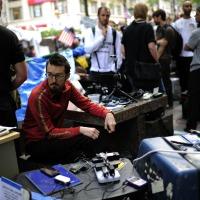[MUSIC UP AND UNDER]
BOB GARFIELD:
From WNYC in New York, this is On the Media. I'm Bob Garfield.
BROOKE GLADSTONE:
And I'm Brooke Gladstone.
[PROTESTORS CHANTING]:
This is what democracy looks like.
MALE PROTESTOR:
Show me what democracy looks like.
[SOUND OF PROTESTORS]
And that's the sound of Occupy Wall Street Thursday night outside New York City Hall. The protesters are no longer allowed to pitch tents in Zuccotti Park near Wall Street, leaving MSNBC's Ed Schultz to answer the obvious existential question with the most rigorous of journalistic tools.
ED SCHULTZ:
Tonight's question: Will the raid on Zuccotti Park strengthen the 99 percent movement? Text A for yes, text B for no, to 662-639...
BROOKE GLADSTONE:
So is it A or B? Deprived of its iconic locale, is it doomed? MIT Civic Media Professor Sasha Costanza-Chock says that within what’s been portrayed as a spontaneous outcry, there's a lot of hidden media savvy.
SASHA COSTANZA-CHOCK:
Occupy, of course, has access to everything from face-to-face and print to real time live streaming. You have hand-painted signs and then you have social media. You have techie activists who are actually building entirely new tools.
There's a lot of media makers who have lots of skills from previous protest experience, and then when Occupy came around they immediately got involved in amplifying the voice of the movement.
The people who set up the Global Revolution live stream, which is a live streaming channel from New York, although there are now live streams from many of the different camps, is a group called Glass Bead Collective, and folks from the Twin Cities indie media, and I first encountered them in 2008 during the Republican National Convention.
BROOKE GLADSTONE:
How important do you think the loss of the iconic location will be? Do you see the possibility that it could just fade away?
SASHA COSTANZA-CHOCK:
I don't think it's likely. I think that it's too early to say whether or not the encampments will be dismantled around the country by coordinated police action. And in some ways it could turn out to be a good thing for the movement if it’s forced to prove its strength by working in many more community spaces. It's kind of like to speak laboratory for democracy.
So people go there and they learn from each other about different strategies for mobilizing, and they take that and they circulate those ideas ideas to their friends and social networks, and more recently the traditional mass media. And they've managed to change the national conversation.
There's enough people now who’ve had their lives transformed by participating in the process. I think that we’ll be seeing the impacts of Occupy for a long time to come.
BROOKE GLADSTONE:
Sasha, thank you very much.
SASHA COSTANZA-CHOCK:
Thank you.
BROOKE GLADSTONE:
Sasha Costanza-Chock teaches civic media at MIT.
